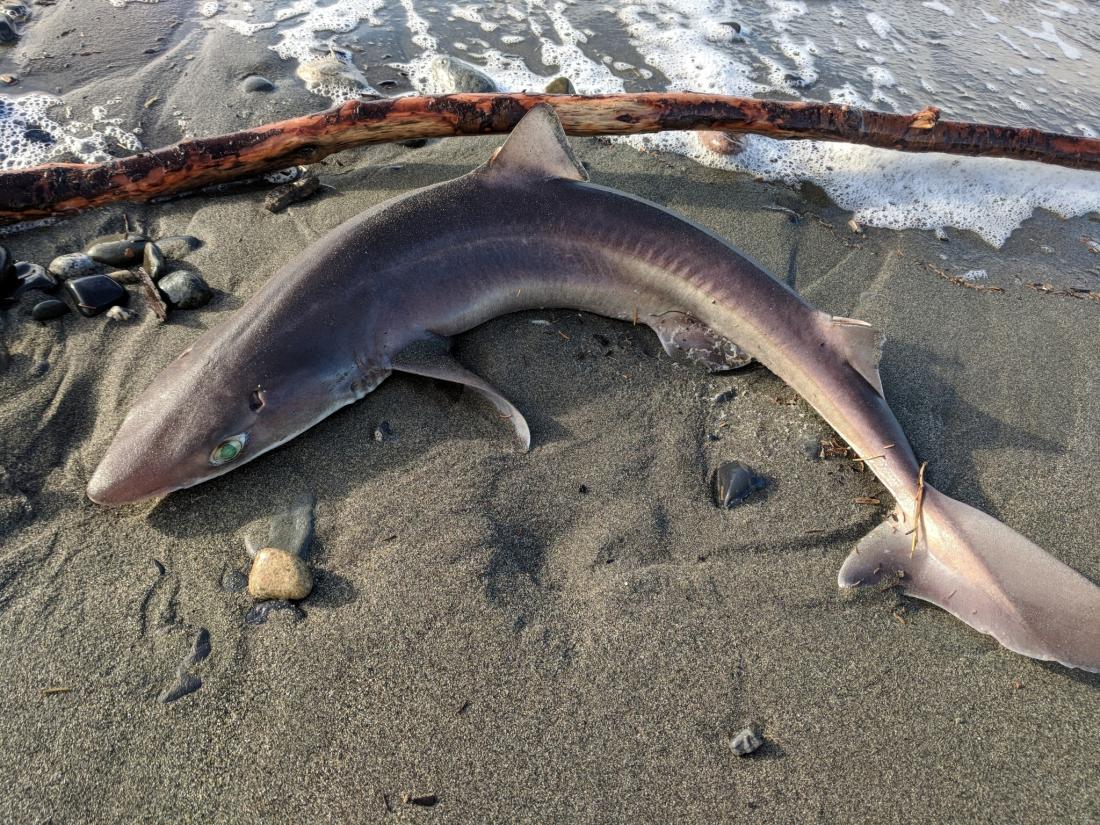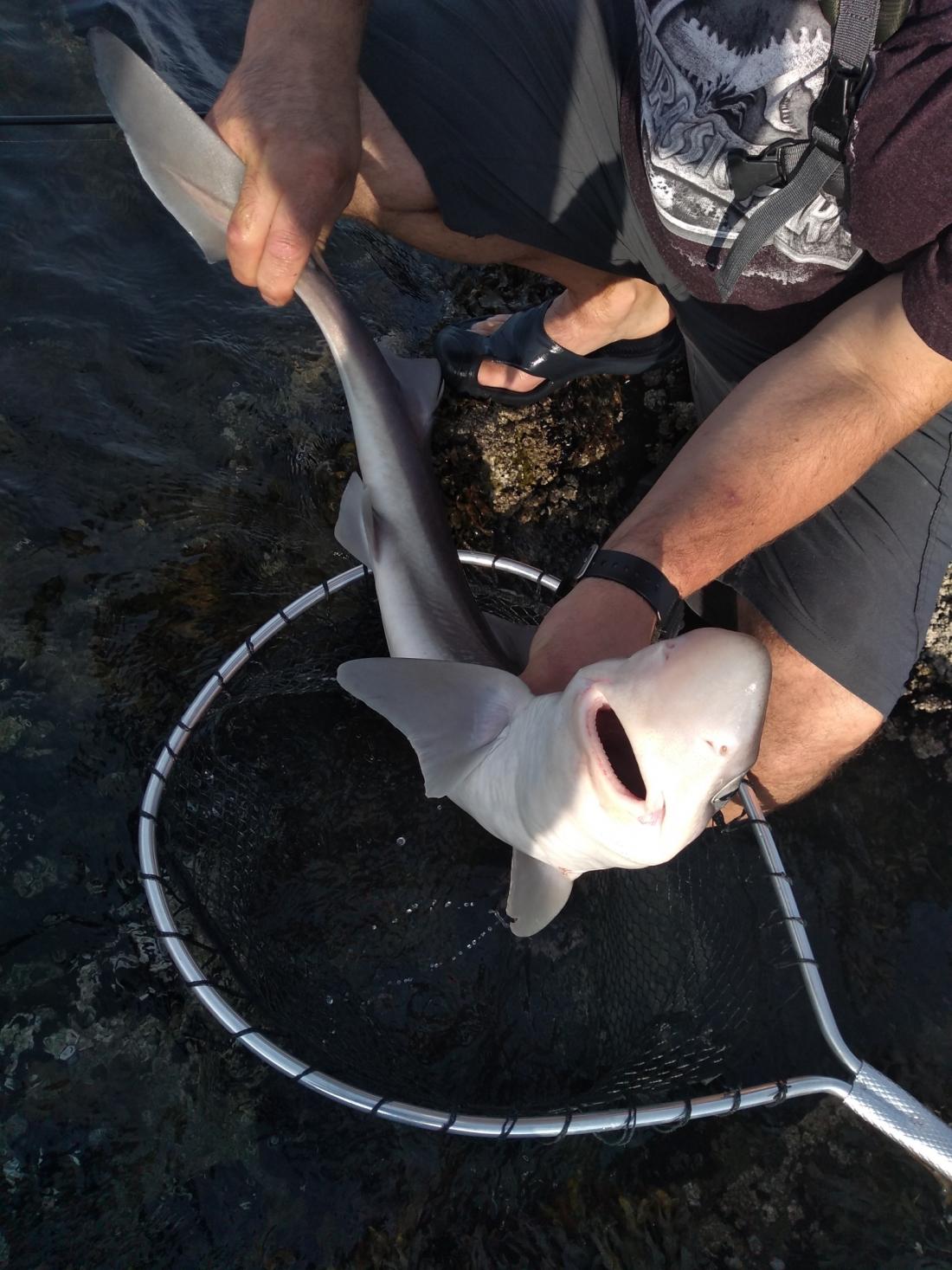Pacific Spiny Dogfish
Squalus suckleyi
The Science
THE SCIENCE
This fish can travel long distances: one dogfish was tagged in Washington state and was recovered off the coast of Japan years later, having made an 8,047 km (5,000 miles) journey! [1,2]

Taxonomic description
- Slim with a thin, tapered snout; gray upper body with a line of white spots along its length, a white lower body, and has venemous spines in front of each dorsal fin. [1,2]
- Averages 0.76 to 1.07 m (2.5 to 3.5 feet) but can reach 1.2 m (4 feet) and weigh about 11 kg (22 lbs). Males are smaller than females. [1,3]
Distribution
- Found from the Bering sea to Baja California, but is most common along the west coast of the U.S. and British Columbia. [1]
Life history
- Can live about 80 years or more, and females reach sexual maturity at around 36 years, while males reach maturity at 19 years old. [1,3]
- Reproduces through internal fertilization, and females carry offspring for 18-24 months before live birthing up to 22 pups in shallow bays in the fall! [1,3]
- Travels in schools with other dogfish, and these schools tend to be segregated by size and gender, with males typically found in shallower waters than females. [1]
Habitat
- Lives in depths above 350.5 m (1,150 feet) but can be found as deep as 1234.4 m (4,050 feet). [1]
- Lives in shallower waters as a juvenile and will move to deeper waters when it matures. [1]
- Prefers waters of 7-15°C (44.6-59°F) [3]
- Preys mostly on small pelagic fish like herring and small invertebrates like shrimp, crab, and squid. [1]
- Preyed on by larger shark species, including larger spiny dogfish, by larger fishes like cod and hake, and marine mammals like seals and killer whales. [1]
The Fishery
THE FISHERY
This fish is often caught as bycatch by anglers with baited hooks as it is an aggressive feeder. [1]

Seasonal availability
- Available year-round. [1]
Regulatory and managing authority
- Managed federally by the NOAA fisheries and, as established by the Magnuson-Stevens Act, the Pacific Fishery Management Council (PFMC) through the Pacific Coast Groundfish Fishery Management Plan (FMP). [1,4]
- As established by the Marine Life Management Act, the California Fish and Game Commission (CFGC) regulates the fishery in state waters, and the California Department of Fish and Wildlife (CDFW) manages this fishery. [12]
- The California Groundfish Collective combines input from the industry and government entities to inform regulatory and management measures for this fishery. [13]
Gear type
- Usually caught by trawl, hook and line, or nets. [4]
Status of the fishery
- Typically caught as bycatch and discarded. [4]
- Currently not in danger of overfishing, but it may be vulnerable to overfishing due because of how long it takes to mature and because of its long gestation period. [3]
Potential ecosystem impacts
- Because it is usually released when caught, fishing for Pacific spiny dogfish in the U.S. is believed to have a minimal impact on the populaion. [3]
- Ecosystem impacts associated with trawling, nets, and hook and line (e.g. benthic disturbance, bycatch, ghost fishing) should apply. [5]
The Seafood
THE SEAFOOD
Shark is a good source of protein high in selenium and vitamins B6 and B12! [1]


Edible portions
- The meat and fins can be eaten. [1,6]
Description of meat
- Raw and cooked meat is white, and the outer flesh can have a red color that turns brown when cooked. It is flaky and firm. [1,6]
- Has a sweet, mild flavor and has more oil than other sharks. [1,6]
- When purchasing spiny dogfish, a slight metallic odor is acceptable but an ammonia taint is not. [6]
Culinary uses
-
This fish is extremely versatile, and can be baked, broiled, fried, grilled, sautéed, or smoked. The fins can be used in shark fin soup. [6]
-
For a recipe for stewed dogfish, visit Food from Portugal. [7]
-
For a curried fish and chips recipe that can substitute dogfish, visit Sorted food. [14]
Nutritional information
-
Nutritional information for 100g of Pacific spiny dogfish is available on the table to the right. [1]
Toxicity report
- No known toxins.
Seasonal availability
- Available year-round. [1]
References
[1] Fishwatch. 2020. Pacific Spiny Dogfish. Web. https://www.fishwatch.gov/profiles/pacific-spiny-dogfish. Accessed 14 July 2020.
[2] Monterey Bay Aquarium. n.d. Pacific spiny dogfish. Web. https://www.montereybayaquarium.org/animals/animals-a-to-z/pacific-spin…. Accessed 14 July 2020.
[3] Bigman, J.S., Ebert, D.A. & Goldman, K.J. 2016. Squalus suckleyi. The IUCN Red List of Threatened Species 2016. Web. https://dx.doi.org/10.2305/IUCN.UK.2016-1.RLTS.T195488A2382480.en. Acce… 14 July 2020.
[4] Gertseva, V., Taylor, I.G. 2012. Status of the spiny dogfish shark resource off the continental U.S. Pacific Coast in 2011. Pacific Fishery Management Council. Web. https://www.pcouncil.org/documents/2012/04/status-of-the-spiny-dogfish-…. Accessed 14 July 2020.
[5] Monterey Bay Aquarium Seafood Watch. n.d. Fishing and Farming Methods. Web. https://www.seafoodwatch.org/ocean-issues/fishing-and-farming-methods. Accessed 14 July 2020.
[6] Seafood Source. 2014. Dogfish. Web. https://www.seafoodsource.com/seafood-handbook/finfish/dogfish. Accessed 24 July 2020.
[7] Barbosa, P. n.d. Stewed Dogfish. Web. https://www.foodfromportugal.com/recipes/stewed-dogfish/. Accessed 24 July 2020.
[8] NOAA's National Ocean Service. 2011. Dogfish. Flickr. Digital image. Web. https://www.flickr.com/photos/usoceangov/6233792845. Accessed 24 July 2020.
[9] Krohn, A. iNaturalist. 2018. Digital image. Web. https://www.inaturalist.org/photos/23518148. Accessed 23 February 2021.
[10] Tsybulnyk, A. iNaturalist. 2020. Digital image. Web. https://www.inaturalist.org/photos/91365065. Accessed 23 February 2021.
[11] Meckel, M. 2018. Photo of fish and chips in Blackpool. Wikipedia. Digital image. Web. https://en.wikipedia.org/wiki/File:Fish_and_chips_blackpool.jpg. Accessed 24 July 2020.
[12] Marine Life Management Act. n.d. California Department of Fish and Wildlife. Web. https://wildlife.ca.gov/Conservation/Marine/MLMA. Accessed 24 August 2020.
[13] The Nature Conservancy. 2015. The California Groundfish Collective. Web. http://www.cagroundfish.org/#our-story. Accessed 2 December 2020.
[14] Sorted food. n.d. Curried Fish and Chips. Web. https://sortedfood.com/recipe/curriedfishandchips. Accessed 29 January 2021.



